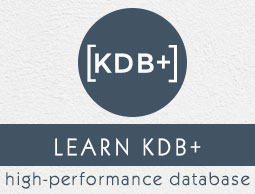
- KDB+ 教程
- KDB+ - 首頁
- Q 程式語言
- Q 程式語言
- Q 語言 - 型別轉換
- Q 語言 - 時間資料
- Q 語言 - 列表
- Q 語言 - 索引
- Q 語言 - 字典
- Q 語言 - 表格
- Q 語言 - 動詞 & 副詞
- Q 語言 - 連線
- Q 語言 - 函式
- Q 語言 - 內建函式
- Q 語言 - 查詢
- Q - 程序間通訊
- Q - 訊息處理器(.Z 庫)
- KDB+ 有用資源
- KDB+ - 快速指南
- KDB+ - 有用資源
- KDB+ - 討論
Q 語言 - 型別轉換
通常需要將某些資料的型別從一種型別更改為另一種型別。標準的型別轉換函式是“$” **雙目運算子**。
三種方法用於將一種型別轉換為另一種型別(字串除外):
- 透過其符號名稱指定所需的資料型別
- 透過其字元指定所需的資料型別
- 透過其短值指定所需的資料型別。
將整數轉換為浮點數
在以下將整數轉換為浮點數的示例中,所有三種不同的轉換方式是等價的:
q)a:9 18 27 q)$[`float;a] / Specify desired data type by its symbol name, 1st way 9 18 27f q)$["f";a] / Specify desired data type by its character, 2nd way 9 18 27f q)$[9h;a] / Specify desired data type by its short value, 3rd way 9 18 27f
檢查所有三個操作是否等價,
q)($[`float;a]~$["f";a]) and ($[`float;a] ~ $[9h;a]) 1b
將字串轉換為符號
將字串轉換為符號,反之亦然,工作方式略有不同。讓我們用一個例子來檢查一下:
q)b: ("Hello";"World";"HelloWorld") / define a list of strings
q)b
"Hello"
"World"
"HelloWorld"
q)c: `$b / this is how to cast strings to symbols
q)c / Now c is a list of symbols
`Hello`World`HelloWorld
嘗試使用關鍵字`symbol`或`11h`將字串轉換為符號將導致型別錯誤:
q)b "Hello" "World" "HelloWorld" q)`symbol$b 'type q)11h$b 'type
將字串轉換為非符號
將字串轉換為除符號以外的資料型別,如下所示:
q)b:900 / b contain single atomic integer
q)c:string b / convert this integer atom to string “900”
q)c
"900"
q)`int $ c / converting string to integer will return the
/ ASCII equivalent of the character “9”, “0” and
/ “0” to produce the list of integer 57, 48 and
/ 48.
57 48 48i
q)6h $ c / Same as above
57 48 48i
q)"i" $ c / Same a above
57 48 48i
q)"I" $ c
900i
因此,要將整個字串(字元列表)轉換為資料型別為**x**的單個原子,需要將表示資料型別**x**的大寫字母指定為**$**運算子的第一個引數。如果以任何其他方式指定資料型別**x**,則會導致轉換應用於字串的每個字元。
廣告